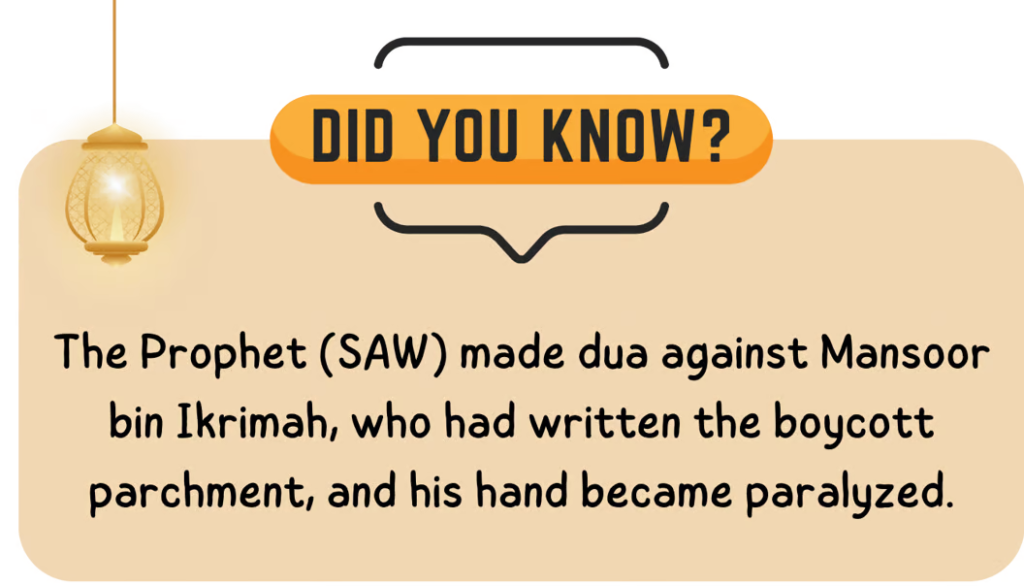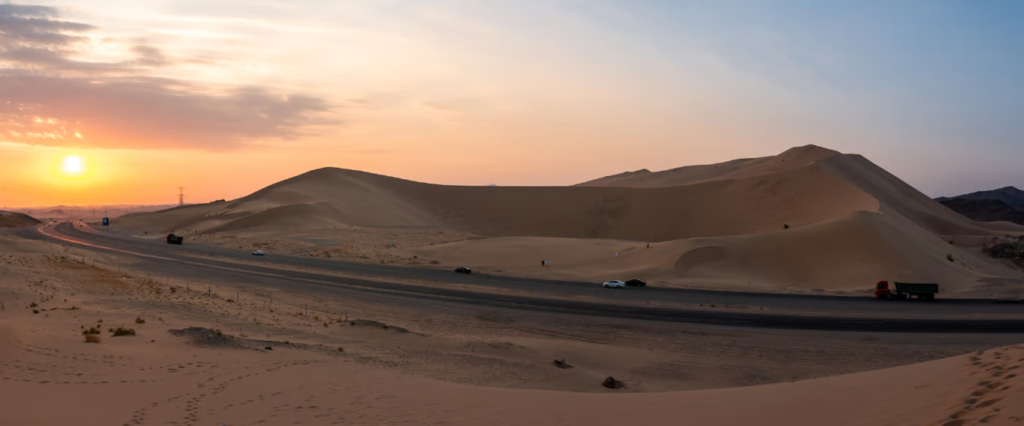The Journey of Islam #
The Beginnings of Islam in Mecca #
Soon after receiving his first revelation from Allah Almighty, Prophet Muhammad (SAW) set out to teach Islam to the people of Mecca. This was a period of intense difficulty and enormous challenges because Mecca was deeply rooted in polytheism, its people worshipped numerous tribal gods and goddesses. And they had even filled the Kaaba itself with some 360 idols. The Prophet’s (SAW) proclamation of monotheism (Belief in One God Alone), was contrary to the religious beliefs in Mecca. Meccans sensed the Islamic principle of monotheism as a threat to their religious traditions and cultural unity. This resulted in an extremely challenging situation for the Prophet (SAW).
Persecution and Resistance #
Under these circumstances, the followers of Islam were subjected to persecution, boycotts, and social exclusion. Many were tortured, and some lost their lives. Prophet Muhammad (SAW) himself faced multiple assassination attempts. Yet, despite these trials, the Prophet (SAW) and his followers persisted in their belief, gradually gathering a small but steadfast group of converts to monotheism.
Trip to Tai’f #
Prophet Muhammad (SAW) aimed to find new allies to protect the growing community of Muslims and help spread the faith. This is why He (SAW) decided to journey to the wealthy city of Taif, about 60 miles from Mecca.

Source: https://www.worldmap1.com/map/at-taif-map
When He (SAW) approached the three influential brothers, the chiefs of Thaqeef, who ruled Taif, with a request to accept the monotheistic faith and support his mission, He (SAW) told them about Islam, worshipping only one true God, and leaving idol worship. But they rejected his message and instead insulted him. Not only did they refuse to listen to his message, but they gathered the children of their tribe to throw stones at him and drive him out of their town. They made fun of him.
The Prophet (SAW) left the town disheartened, with his ankles bleeding from the stones and his shoes covered in blood. He (SAW) found shelter in a nearby orchard. At that moment, Angel Jibreel came to the Prophet (SAW) and asked him that if he (SAW) wished, Allah Almighty could order an angel to collapse the two mountains surrounding the people of Tai’f and destroy them.
Yet, despite the hardship, the Prophet (SAW) demonstrated patience and forbearance, choosing not to curse the people of Tai’f but rather to pray for their guidance. He chose to be compassionate and merciful and instead asked Allah Almighty to forgive them and give them guidance in accepting Islam.
Although the people of Taif did not initially accept Islam, Prophet Muhammad’s (SAW) prayer for their guidance was later answered. The city of Taif accepted Islam a few years later and has remained a stronghold of the faith ever since.
The Social Boycott #

The Quraysh tribe, the inhabitants of Mecca, wanted to kill Prophet Muhammad (SAW) as Islam spread. But He (SAW) was safeguarded by his uncle, Abu Talib, who also urged other members of their tribes, Banu Hashim and Banu al-Muttalib, to make similar commitments. However, a different uncle, Abu Lahab (who was a sworn enemy of Islam), declined to protect the Prophet (SAW) and supported the people of Quraysh instead. The Quraysh made the decision to punish them by urging a complete social boycott of the tribes that had taken care of the Prophet (SAW). As a result, no one was allowed to talk to them, make friends with them, conduct any business with them, or marry them. They wrote it on parchment and hung it on the Kaaba to make it official. The Quraysh declared that they would end the boycott only if the Prophet (SAW) was handed over to them. This happened in the 7th year of Islam.
The hardships of the boycott #
The Prophet (SAW) was compelled to leave Mecca and relocate to She’eb Abi Talib, a stretch of one of the canyons that led down to Mecca, together with Abu Talib and clan members of the Banu Hashim and Banu al-Muttalib tribes.
They suffered greatly due to the boycott and endured pain for many months. The food was very scarce. The women, and especially the kids and nursing infants, would cry in hunger, and this could be heard across the valley. The merchants were instructed by the Quraysh not to sell anything to them. Prices were raised to make it impossible for them to purchase even necessary items. For three years, they persisted in that condition.
A few nice Qurayshi people discreetly provided them with food, but other than that, they were completely shut out. Despite all this hardship, the Prophet (SAW) continued to invite non-Muslims to Islam.

The end of the boycott #
Some compassionate people among the Quraysh were beginning to feel that what was happening was wrong. Abu Talib took this opportunity to negotiate with the Quraysh. He informed them that the Prophet (SAW) had received a revelation from Allah Almighty that insects had destroyed the parchment that hung on the Kaaba. The lines “In Your Name, O Allah” were all that was left of the paper, according to Abu Talib. The Quraysh were then challenged by Abu Talib, who warned them that if the Prophet’s (SAW) allegation turned out to be untrue, he would no longer stand in their way. But if the Prophet (SAW) had been telling the truth, the Quraysh should end the boycott. The Quraysh took Abu Talib’s challenge in stride. When Quraysh checked the parchment, it was exactly as the Prophet (SAW) had described it.
Hence, the agreement was torn up, and the people were finally allowed to return to Mecca.

The Journey of Islam #
The Beginnings of Islam in Mecca #
Soon after receiving his first revelation from Allah Almighty, Prophet Muhammad (SAW) set out to teach Islam to the people of Mecca. This was a period of intense difficulty and enormous challenges because Mecca was deeply rooted in polytheism, its people worshipped numerous tribal gods and goddesses. And they had even filled the Kaaba itself with some 360 idols. The Prophet’s (SAW) proclamation of monotheism (Belief in One God Alone), was contrary to the religious beliefs in Mecca. Meccans sensed the Islamic principle of monotheism as a threat to their religious traditions and cultural unity. This resulted in an extremely challenging situation for the Prophet (SAW).
Persecution and Resistance #
Under these circumstances, the followers of Islam were subjected to persecution, boycotts, and social exclusion. Many were tortured, and some lost their lives. Prophet Muhammad (SAW) himself faced multiple assassination attempts. Yet, despite these trials, the Prophet (SAW) and his followers persisted in their belief, gradually gathering a small but steadfast group of converts to monotheism.
Trip to Tai’f #
Prophet Muhammad (SAW) aimed to find new allies to protect the growing community of Muslims and help spread the faith. This is why He (SAW) decided to journey to the wealthy city of Taif, about 60 miles from Mecca.
Source: https://www.worldmap1.com/map/at-taif-map
When He (SAW) approached the three influential brothers, the chiefs of Thaqeef, who ruled Taif, with a request to accept the monotheistic faith and support his mission, He (SAW) told them about Islam, worshipping only one true God, and leaving idol worship. But they rejected his message and instead insulted him. Not only did they refuse to listen to his message, but they gathered the children of their tribe to throw stones at him and drive him out of their town. They made fun of him.
The Prophet (SAW) left the town disheartened, with his ankles bleeding from the stones and his shoes covered in blood. He (SAW) found shelter in a nearby orchard. At that moment, Angel Jibreel came to the Prophet (SAW) and asked him that if he (SAW) wished, Allah Almighty could order an angel to collapse the two mountains surrounding the people of Tai’f and destroy them.
Yet, despite the hardship, the Prophet (SAW) demonstrated patience and forbearance, choosing not to curse the people of Tai’f but rather to pray for their guidance. He chose to be compassionate and merciful and instead asked Allah Almighty to forgive them and give them guidance in accepting Islam.
Although the people of Taif did not initially accept Islam, Prophet Muhammad’s (SAW) prayer for their guidance was later answered. The city of Taif accepted Islam a few years later and has remained a stronghold of the faith ever since.

The Year of Sorrow #
In the year 619 A.D., about 10 years after the birth of Islam, two people very close to the Prophet (SAW) passed away. They were Khadeejah bint Khuwaylid, his wife, and his uncle, Abu Talib. This year was very upsetting and sad for the Prophet (SAW), and hence it is known as the ‘year of sorrow’.
Hijrah: The Migration from Mecca to Madinah #

As the persecution and violence increased in Mecca, Muslims sought refuge in other regions. Their first migration was to Abyssinia (modern-day Ethiopia), where they were well-received and could practice their religion freely. However, the Islamic community could only thrive and prosper in a place where they could gather, worship, and live by their ideologies. Madinah emerged as a beacon of hope for such a place.
Madinah was a city troubled by inter-tribal feuds and bloodshed. The people here sought a leader who could broker peace and harmony, and they found this in Prophet Muhammad (SAW). Several representatives from Madinah met Prophet Muhammad (SAW) during the yearly pilgrimage and gave him open invitations to migrate and bring peace into their tumultuous city.

In 622 AD, Prophet Muhammad (SAW) and the Muslims decided to migrate to Yathrib. The migration, known as Hijrah, was a strategic and meticulously planned move. Muslims left in small groups, discreetly, to evade Quraysh’s attention. Prophet Muhammad (SAW) and his close companion, Abu Bakr, were the last to leave, risking their lives as the Quraysh pursued them.

Jabal al-Thawr is the mountain containing the cave in which the Prophet (SAW) and Abu Bakr sought shelter for three days and nights from the Quraysh. This occurred on their way to Madinah. When they were hiding inside the cave, Allah Almighty sent a spider to spin a web across the entrance to the cave and also commanded two doves to fly down between the spider and the tree, make a nest, and lay eggs. Upon seeing the spider’s web and dove’s nest, the Quraysh concluded that no one could have entered the cave and left.

The cave on Jabal al Thawr mountain where the Prophet (SAW) and his companion, Abu Bakr, hid from the Quraysh.
Arrival in Madinah #
Upon their arrival in Madinah, the Muslims were greeted with hospitality and brotherhood, a stark contrast to their oppressive experiences in Mecca. The successful migration to Madinah marked a significant revolution in Islamic history. Madinah provided a safe haven for Muslims to practice their religion, establish a Muslim state, and formulate laws governing their lives. The Hijrah combined two significant aspects: freedom from oppression and the ability to fully express one’s faith and identity.
The Battle of Badr

One of the first major battles between Muslims and the Quraysh tribe occurred at Badr, in modern-day Saudi Arabia, between Mecca and Madinah. This was a time of extreme tension between the two groups.
The iconic Battle of Badr was fought on the 17th of Ramadan, in the 2nd year of Hijrah in the Islamic calendar. It is remembered every Ramadan on its anniversary and throughout the Islamic year. It is hailed as one of the most important military victories for Muslims.
Muslims had been on the defensive until the conflict of Badr, but the triumphant victory that lay ahead would mark a significant turning point for Muslims. It changed the status of Muslims on the Arabian Peninsula and the spread of Islam.

The Epic Encounter: Battle of Badr Events #
Before the battle, the Muslims had been given permission by Prophet Muhammad (SAW) to attack a wealthy merchant caravan belonging to the Quraysh tribe on their way past Madinah. This caravan was being led by a person named Abu Sufyān. He was the head of the prominent Umayyad clan and one of the leading enemies of Muslims when they were persecuted in Mecca. The Quraysh routinely sent spies to monitor the progress of the Muslims in Madinah and informed the tribe that the Muslims were about to intercept Abu Sufyān’s caravan.
Upon hearing this, the Quraysh assembled and sent their army, which consisted of about 1,000 soldiers and 100 horses. This was led by Abu Jahl, who was another big enemy of Muslims in Mecca. The Meccan army greatly outnumbered the Muslims. By comparison, the Muslims had only a tiny army of about 300 soldiers and two horses. Everyone believed that the big Quraysh army would easily defeat the Muslims.
The Devine Help #
The Muslims, being led by Prophet Muhammad (SAW) himself, lured Abu Sufyān’s army into battle at Badr. As the two armies charged towards one another, Prophet Muhammad (SAW) threw a handful of sand towards the Quraysh, and it flew into the eyes and noses of many of the opposing Meccans. Prophet Muhammad (SAW) kept praying for the Muslims and requested Allah Almighty for help. Allah Almighty answered his request and sent help in the form of angels, and despite the superior numbers of the Meccan forces, the Muslim army marked a complete victory. Many prominent Meccan leaders were killed in this battle, including their leader, Abu Jahl.
Allah Almighty mentions in the Holy Quran in Surah Al-Anfal (Chapter 8, verses 9-10):
إِذْ تَسْتَغِيثُونَ رَبَّكُمْ فَٱسْتَجَابَ لَكُمْ أَنِّى مُمِدُّكُم بِأَلْفٍۢ مِّنَ ٱلْمَلَـٰٓئِكَةِ مُرْدِفِينَ ٩
Translation: [Remember] when you cried out to your Lord for help, He answered, “I will reinforce you with a thousand angels—followed by many others.”
وَمَا جَعَلَهُ ٱللَّهُ إِلَّا بُشْرَىٰ وَلِتَطْمَئِنَّ بِهِۦ قُلُوبُكُمْ ۚ وَمَا ٱلنَّصْرُ إِلَّا مِنْ عِندِ ٱللَّهِ ۚ إِنَّ ٱللَّهَ عَزِيزٌ حَكِيمٌ ١٠
Translation: And Allah made this a sign of victory and reassurance to your hearts. Victory comes only from Allah. Surely Allah is Almighty, All-Wise.
Allah Almighty reminds Muslims about his help in the Quran in Surah Al-Anfal (Chapter 8, verse 17):
فَلَمْ تَقْتُلُوهُمْ وَلَـٰكِنَّ ٱللَّهَ قَتَلَهُمْ ۚ وَمَا رَمَيْتَ إِذْ رَمَيْتَ وَلَـٰكِنَّ ٱللَّهَ رَمَىٰ ۚ وَلِيُبْلِىَ ٱلْمُؤْمِنِينَ مِنْهُ بَلَآءً حَسَنًا ۚ إِنَّ ٱللَّهَ سَمِيعٌ عَلِيمٌۭ ١٧
Translation: It was not you [believers] who killed them, but it was Allah Who did so. Nor was it you [O Prophet] who threw [a handful of sand at the disbelievers], but it was Allah Who did so, rendering the believers a great favor. Surely Allah is All-Hearing, All-Knowing.

In the Battle of Badr, 14 Muslim soldiers were martyred, while the Quraysh army lost 70 of their important warriors. For the young Muslim community, the victory at Badr was a turning point that was considered miraculous. The Battle of Badr was extremely important because it confirmed Prophet Muhammad’s (SAW) rising authority and increased Muslim power and self-confidence. This conflict demonstrated that Allah Almighty is the highest power and that He helps people who have faith in Him.
The Treaty of Hudaybiyyah #

The pact of Hudaybiyyah, an important event in Islamic history, was signed six years after Prophet Muhammad (SAW) and his followers migrated to Madinah. Despite winning the Battle of Badr, the Muslims at that time lacked the strength to defeat the Meccans. But they desired to go to the sacred Kaaba and make ‘Tawaf’ (circumambulation of the Kaaba).
The Prophet (SAW) and the Quraysh tribe signed the crucial treaty then. The Hudaybiyyah Treaty had several advantages, including a reduction in hostility between the two sides and a declaration of peace. The Prophet Muhammad (SAW) and his companions were also permitted to enter Mecca the next year for what is now known as the first pilgrimage as a result of the agreement.

Historical context before the treaty #
Prophet Muhammad (SAW) had a dream that he was performing Tawaf around the Holy Kaaba in Mecca about six years after the journey to Madinah. The Prophet (SAW) narrated this dream to his companions the following day, and He (SAW) was advised by his companions to go to Mecca and perform Umrah. Thus, a caravan of 1,400 pilgrims in ‘Ihram’ clothes set out for Mecca.
When the Quraysh learned about the gathering, they became worried, and, despite the Muslims being unarmed, they dispatched an army of 200 men under the command of Khalid bin Walid to block the Muslim caravan from entering the city. The Prophet (SAW) changed his course after observing this and decided to stay in “Al-Hudaybiyyah,” a less well-known location situated about 9 miles (14.5 km) outside of Mecca. This is when an agreement for peace was signed by the Muslims of Madinah and the Quraysh of Mecca beneath a well-known acacia tree known as “Bait Ridwan“.

The Meccan leaders, the Prophet Muhammad (SAW), and his companions held a lengthy and in-depth discussion before deciding on the terms of Sulhul Hudaybiyyah. Some of the important points of the treaty were as follows:
- The Muslims will go back to Medinah without performing Umrah. But in return, they will be allowed to come back next year to peacefully stay in Mecca for 3 days and perform Umrah.
- The Treaty of Hudaybiyyah declared a 10-year truce between both parties, and everyone agreed to live in safety and peace during this time.
- According to the treaty terms, if anyone from Mecca entered Madinah, they would be returned safely to the Quraysh. However, if anyone from Madinah entered Mecca, they wouldn’t be treated with the same courtesy.
- Any tribe wanting to join the Muslims would be allowed to do so, and thus, the agreement between any tribe and the Prophet (SAW) was ruled to be legal. Similarly, the Muslims would not prevent anyone from joining the Quraysh and signing an agreement with them.

Significance of the Treaty #
Despite the fact that several of the Treaty of Hudaybiyyah’s points were unfavorable to Muslims, its significance in Islamic history cannot be overstated. Following the signing of the treaty, the Quraysh began to acknowledge Prophet Muhammad (SAW) as the ruler of Madinah, and the Muslims were finally free to form alliances with other tribes. The pact put an end to the long conflict between the Meccans and Muslims, and the ten-year cease-fire allowed Muslims to openly practice their religion and spread Islam throughout the rest of the Arabian Peninsula.
The Conquest of Mecca: A Turning Point in Islamic History #
The conquest of Mecca holds great significance in the history of Islam. It was a pivotal moment that marked the triumph of Prophet Muhammad (SAW) and his followers over their enemies in Mecca.
Breaking the Treaty of Hudaybiyyah #
Under the Treaty of Hudaybiyyah, a ten-year peace agreement was established between the Muslims and the Quraysh. However, in the 8th year of Hijrah, the Quraysh violated the treaty by entering into an alliance with a neighboring tribe against the Muslims. This breach of trust forced Prophet Muhammad (SAW) to plan a military campaign to conquer Mecca and finally establish the authority of Islam in his birthplace.
The Conquest #
In January 630 CE (8th year of hijrah), Prophet Muhammad (SAW) and an army of ten thousand Muslims marched towards Mecca. The sheer magnitude of their force sent shockwaves throughout the region. As the Muslim army approached Mecca, many influential figures of the Quraysh surrendered without any resistance, realizing they had no chance of defeating the Muslims.
Bloodless Victory #
Remarkably, the conquest of Mecca was achieved without a drop of bloodshed. Prophet Muhammad (SAW), in a stunning display of mercy and forgiveness, declared a general amnesty, granting safety to all who sought refuge in the Kaaba or the homes of a few specific individuals. This act of clemency solidified Islam’s message of compassion and forgiveness, earning the respect and admiration of the people of Mecca.
Destruction of Idols #
The conquest of Mecca played a vital role in solidifying the foundation of Islam. With the city under their control, the Muslims gained access to the Kaaba. The prophet (SAW) destroyed all the idols in the Kaaba and ordered Muslims to cleanse the entire city of idols. And so, once again, the sacred house of Allah Almighty was restored to monotheism. This monumental event marked a turning point in the spread and establishment of Islam as the dominant religion in the Arabian Peninsula.

The Aftermath #
Following the conquest, Islam continued to flourish, and the Arabian Peninsula embraced the new faith. The Muslims were no longer seen as a persecuted minority but rather as a powerful community that commanded respect. This newfound authority enabled them to propagate the message of Islam far and wide, leading to the rapid expansion of the faith beyond the Arabian Peninsula’s borders.
The conquest of Mecca symbolized the triumph of truth over falsehood, justice over oppression, and morality over immorality. It demonstrated that Prophet Muhammad (SAW) and his followers had prevailed not through brute force but through their unwavering faith, perseverance, and adherence to the principles of Islam.




